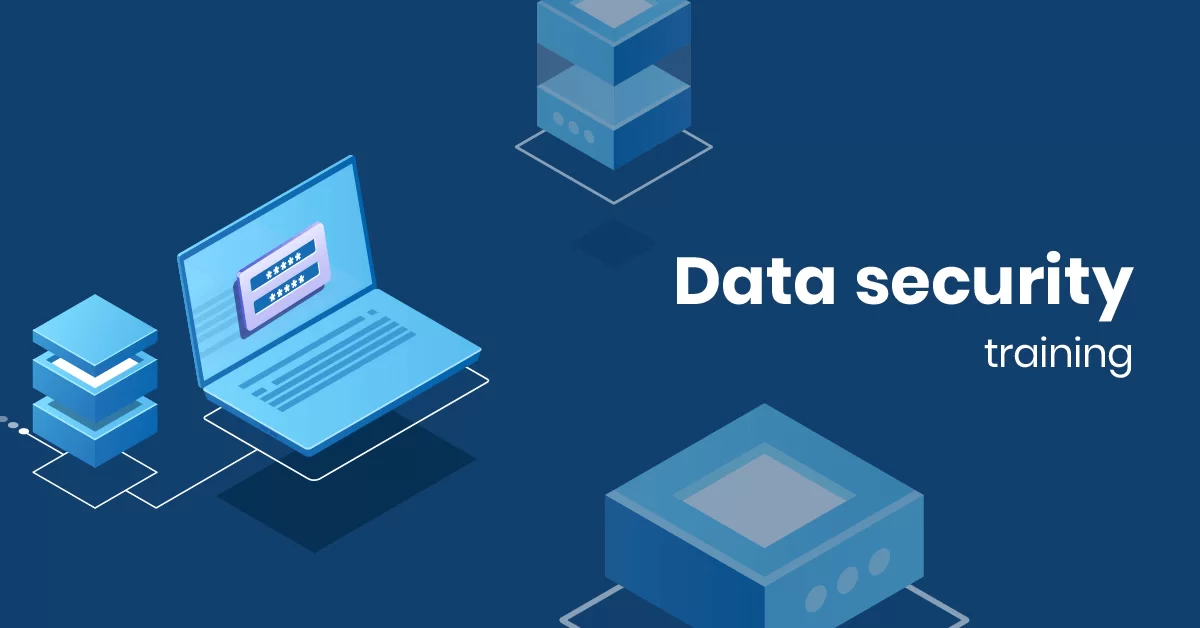Unfortunately, none of it is safe. Data breaches have become commonplace, and the consequences are never mild. Data compromise of any kind can disrupt your operations, harm your reputation, initiate legal action against you, and result in hefty fines. According to a recent Cost of a Data Breach Report by the Ponemon Institute and IBM security, the average cost of a data breach amounts to 3.92 million dollars!
Most companies have experienced a data breach, usually as a result of human error. Accusing employees of irresponsible behavior and negligence is pointless and unfair. Instead, deploy data security training for your staff to minimize the possibility of similar incidents in the future. Or to prevent them in the first place.
Before we dive into best practices and tips, let’s take it from the beginning:
What is data security training?
Data security training educates employees on best practices that protect data from destruction, loss, modification, theft, or disclosure. Since data security can be compromised either by mistake or intentionally, information security training should focus both on accidental data mishandling and protection from malicious attempts.
There’s often a confusion between cybersecurity and data security. While there are many similarities, there’s one key difference. Cybersecurity refers to protecting data and systems, so that data and information that circulates in cyberspace isn’t stolen or compromised. Data security, however, isn’t exclusively about data stored in cyberspace. A lost printed document with an employee’s social security number, for instance, is also data loss.
So, while cybersecurity training for employees discusses attempts against systems and data in cyberspace, data security training covers offline information and threats as well.
How do I train my employees on data security?
First things first: data security training for employees has to be deployed company-wide. Data compromise or theft can happen in the blink of an eye, and anyone can cause it.
Which is why all employees should realize that it’s not only the IT department’s job to protect company data. It’s their responsibility, too. Sure enough, the level of training might vary. Still, from IT staff to the front desk, everyone must have a basic knowledge of common threats and defenses.
1. Deploy data security training from day one
Even if you don’t go into much detail, offer data security awareness training early on. This should happen for two reasons. One, to minimize the risk of a data breach due to ignorance of best practices. Two, so that new hires realize that protection against data compromise is part of your company culture and not some random training you conduct just for the sake of it.
New employees receive a lot of new information during onboarding. At this point, they’re unlikely to retain much. So, communicate basic data protection rules to follow. For example, using antivirus software, creating secure passwords, and respecting the clean-desk policy.
2. Follow a formal training approach
Hanging an infographic in the break room or sending a video with data security tips is a great, casual way to keep the information fresh in your employees’ minds. “Casual” is the keyword here. Because these practices don’t qualify as proper data security and protection training. Some employees won’t watch the video, and others won’t even notice the infographic — you’ll never know.
Data security training in the workplace should be formal, and it should have a clear structure. Ideally, you also want to be able to update it frequently and with little effort. The solution? Organize your security awareness training material into an easily manageable course using a powerful enterprise LMS, like eFront.
Data security covers diverse and, for some, challenging topics. An effective way to ease knowledge retention is to break down the training content into small, digestible pieces. Mobile apps give employees the choice to go through the microlearning content on the move or at home. Simulations and branching scenarios provide further practice opportunities, as well as advanced assessment tools and certification management. All in all, it’s the ideal training system for data security awareness.

3. Discuss physical security
Since a data breach can (and often does) occur offline, data privacy training should discuss physical security as well. Implementing a clean desk policy will ensure that employees don’t leave documents with sensitive data sitting on their desks.
You can also ask employees to shred documents they no longer need instead of throwing them in the dustbin. Other dangerous practices to address are unlocked or unattended devices, as well as granting access to the company premises without verifying the visitor’s identity.
4. Repeat regularly
The threat is real, so make sure employees don’t forget about it. OK, that sounded a bit sinister. But the point is, employees will forget most of what they’ve learned after a few months. Also, as time passes by, some might begin to bypass data hygiene rules or lower their alertness.
To make sure this doesn’t happen, data security training for employees should be a consistent effort. There are many ways you can keep data security top of mind. Some companies choose to conduct refresher seminars every quarter or send relevant videos and articles with recent news.
If you deploy privacy & data security training online, things are even simpler. The system automatically sends notifications when a data security certification expires or when there’s a course update. Your task is to stay up to date with data security news and update your training accordingly.
5. Explore common data security threats
Ideally, each company should run a data security and protection training needs analysis to identify weak spots and common threats. In any case, the following topics are a good place to start with:
- Password security: employees should create strong, unique passwords for each account and never share their credentials. Using a password manager app is also advisable.
- Physical security: discuss basic data hygiene rules that minimize breaches caused by unauthorized physical access to data.
- Phishing emails and social engineering scams: employees should be able to recognize attempts that take place via email, over the phone, or even in person. Advise them against disclosing sensitive information or authorizing money transfers.
- Malware: a basic overview of spyware, viruses, etc., that hide in links, files, and software programs. Explain how malware can shut your systems down and attack data.
6. Don’t forget your remote and mobile employees
Data breaches are not always an “inside job.” Remote employees, as well as those who take regular business trips, can also cause a data breach. So, you should not only include remote and mobile employees in data privacy and security training. You should also focus on the intricacies of their working style and habits.
For example, remote and mobile employees should be instructed to use all work-related devices responsibly. This starts with regularly updating their antivirus software and never losing sight of their devices. Prompt them to encrypt their devices so that all data remains safe in case of loss. Another issue to address is the safe usage of public Wi-Fi, as it’s a common point of entry to data.
7. Nothing beats the real thing
“Is it safe to share your password with a colleague if they pinky swear not to reveal it to anyone else?” Duh, no! But, it’s easy to answer questions when you’re doing a quiz. So is making the right decision and managing situations that are under your control. The actual challenge is to handle an attack you don’t know is coming.
When it comes to data security, assessments can gauge your employees’ theoretical knowledge. A simulated scam, preferably well after the training is complete, will test what matters most: their alertness. And if your IT department is too busy for that? Find a reliable IT security vendor who will also analyze your response capabilities after the fact.
Conclusion
Nothing is hidden under the sun, especially from prying eyes and cybercriminals. To ensure valuable company and customer data stays with you, make data security training for employees the cornerstone of your data protection plan.



